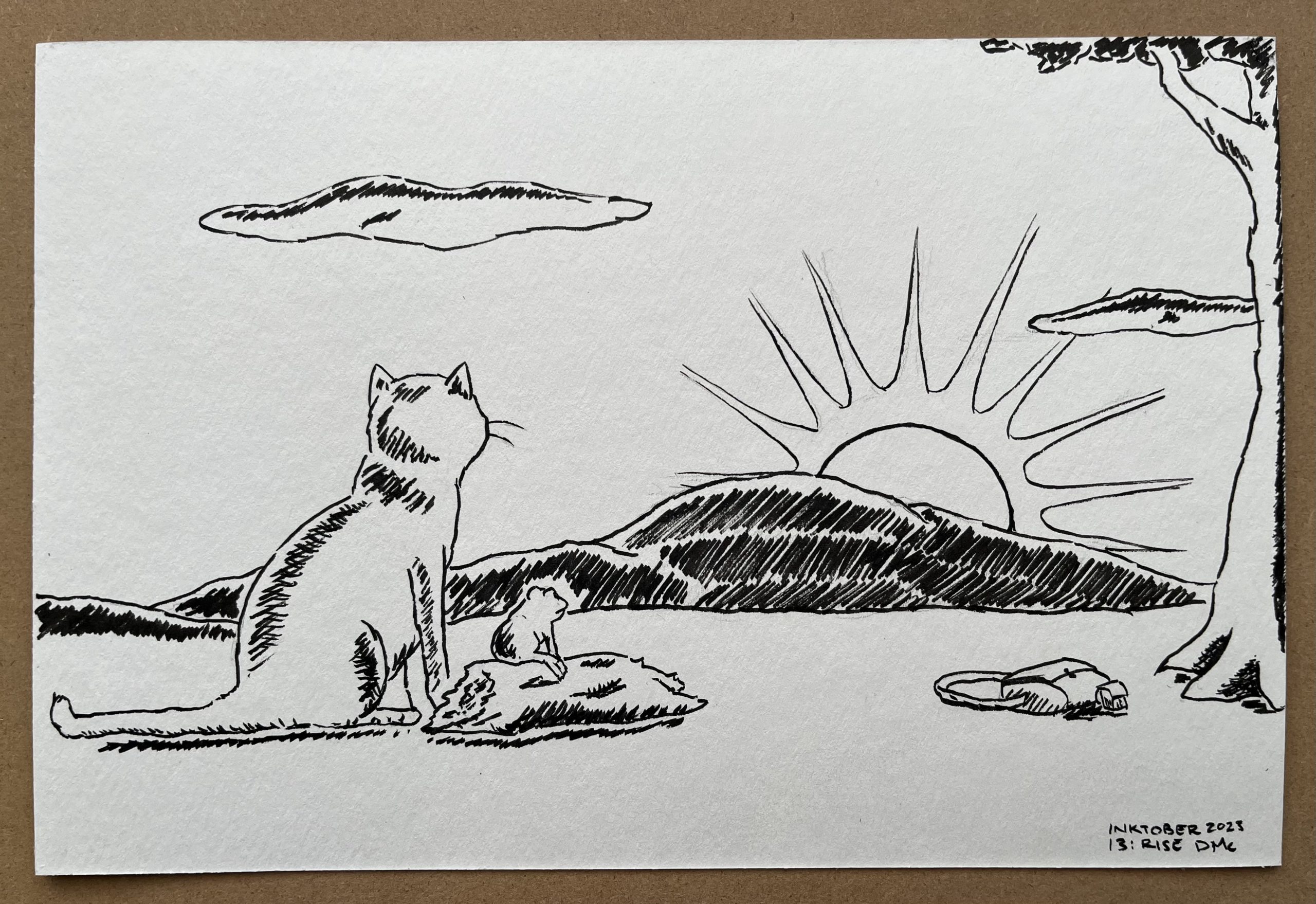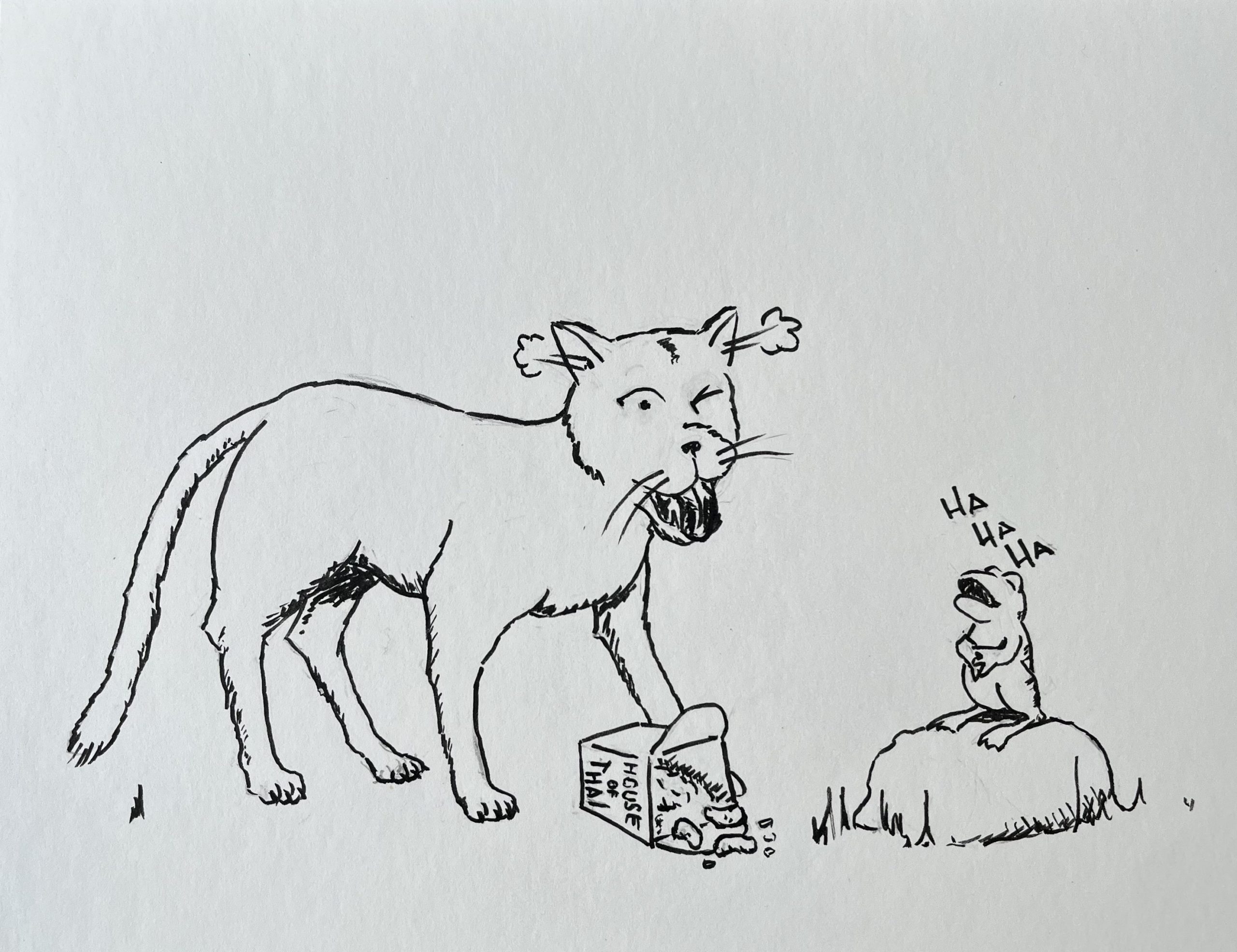Rudy Rucker posted the entirety of the Mirrorshades cyberpunk anthology from 1986. John Shirley, who also contributed to the book, said in a post on Mastodon, “A *free* book pirated by its authors. For many years in print, we decided to allow it to be free online…”
Category: General
Idea
An idea is a thought. It’s a thought that holds more than you think it does when you receive it.
— David Lynch, Catching the Big Fish
Inktober ’23 Prompt 31: Fire
Today’s prompt, the last one for 2023, was “fire”.
Whew! Did it!
Tried to get a little Kirby in the reflection on the metal, but man. That guy was the king.
Inktober ’23 Prompt 30: Rush
The daily prompt was “rush”.
Inktober ‘23 Prompt 29: Massive
Today’s prompt was “massive”.
Whew! Look at the size of that wasp!!
Also, note to self: Don’t pick photos with huge swaths of blurry wasp parts. Still pretty happy with it though.
Inktober ’23 Prompt 28: Sparkle
Today’s prompt was “sparkle”.
Guitars are fussy things to draw. Compound curves all over the place, big areas with subtle bends and so many fine, long, straight lines.
I own two Gretsch hollow-bodies and one of them is literally sparkly. Its finish is this amazing silver-blue icy glitter. I got stumped trying to represent that with black and white ink, so I’ll come back to it later.
For now, this the other one. Let’s say it metaphorically sparkles.
I do like the way the not quite completely blacked-in F-hole provides a little depth.
(Guitar nerds, it’s 1959 6119 Tennessean with a single bridge pickup.)
Inktober ‘23 Prompt 27: Beast
Today’s prompt was “beast”.
Whomst is the beast anyway?!?
Inktober ’23 Prompt 26: Remove
Today’s prompt was “remove”.
I am really digging this dot shading. I need to work on the range of dark to light, but I still think I’m doing a better job of shading with this than I ever have with cross-hatching.
Joumana Medlej
Joumana Medlej specializes in art based on Kufic script, but also makes deeply layered objects (see the Treasure Boxes) and publishes historical and instructional books. She makes her own inks, and one of her books provides guidance for doing that yourself.
My visual language is rooted in the artistic culture of my native Middle East: I shape the ancient Kufic script to create images made of meaning. Free from iconography, but not obviously legible, the work bypasses the mind to engage a deeper recognition. The geometric compositions refer us not to the world of forms but to a cosmic order; their architectural quality generates a space in which one is held in contemplation and stillness.

It’s all just amazing work.
Reduce, Reuse, Recycle
David Shrigley: Artist pulps 6,000 copies of The Da Vinci Code and turns them into 1984
Shrigley spent what he describes as “a six-figure sum” publishing his edition of 1984s. This is his justification for each book going on sale at £495, a price as eye-opening as a rat in Room 101, to use 1984 parlance.
A portion of the profits will be donated to Oxfam, who have also been paid for the hire of the venue and will receive the proceeds of specially designed tote bags merchandise.“Four hundred and ninety five pounds seems like a kind of crazy price,” admits Shrigley, “However I have made an artwork, a signed print to go in it, which is based on a lot of the themes of 1984. So people are perhaps willing to pay that price for an original artwork of mine, where they might not be for the book, so I’ve sort of hedged my bets.”
Shrigley says it wasn’t about literary criticism, and I believe him, but also The Da Vinci Code is possibly the worst book I have ever read all the way through.
Inktober ’23 Prompt 25: Dangerous
The daily prompt was “dangerous”.
There was a story on the radio today about a study done in South Africa that showed some animals are more afraid of human voices than of lions. Then I saw a photo of some javelinas and here we are.
Inktober ’23 Prompts 24, 19, & 20: Shallow, Plump, Frost
The daily prompt was “shallow”. I also included prompt 19, “plump” and prompt 20, “frost”.
As long as the Garys have been in my life I’ve wondered what Gary would do when Gary went into hibernation. I think he’d stick around to make sure everything was okay, then go find someplace out of the cold, but come back regularly to make sure Gary was still tucked in.
Inktober ’23 Prompt 23: Celestial
The daily prompt was “celestial”.
This is the Nebra Sky Disc, a Bronze Age map of the sky found in Germany in 1999.
Inktober ’23 Prompt 22: Scratchy
The daily prompt was “scratchy”.
Inktober ’23 Prompt 21: Chains
The daily prompt was “chains”.
Inktober ’23 Prompt 18: Saddle
The daily prompt was “saddle”.
Inktober ’23 Prompts 16 & 17: Angel and Demon
Grouping two prompts into one drawing: “angel” and “demon”.
Inktober ’23 Prompt 15: Dagger
The daily prompt was “dagger”.
Inktober ’23 Prompt 14: Castle
The daily prompt was “castle”.
Inktober ’23 Prompt 13: Rise
The daily prompt was “rise”.
Inktober ’23 Prompt 12: Spicy
The daily prompt was “spicy”.
Inktober ’23 Prompt 11: Wander
I was traveling during the second week of October and got behind. Prompt 11 was “wander” and marks the return of my friends Gary and Gary.
Inktober ’23 Prompt 10: Fortune
Today’s prompt was “fortune”.
Inktober ’23 Prompt 9: Bounce
Today’s prompt was “bounce”.
Inktober ’23 Prompt 8: Toad
Today’s prompt was “toad”.
Inktober ’23 Prompt 7: Drip
Today’s prompt was “drip”.
Inktober ’23 Prompt 6: Golden
Today’s prompt was “golden”.
Inktober ’23 Prompt 5: Map
Day 5’s prompt was “map”.
Not all maps are on paper.
A Prophet Without a Scribe, or John the Lonesome

I found this at a thrift store a few days ago. I wasn’t sure what I’d do with it, but it’s a twofer for me. I’m fascinated by religious icons (in the orthodox sense) and I love finding art objects that meant something to someone at some point but have ended up discarded.
I wasn’t sure which saint this was when I picked it up, but was pretty confident it was probably one of the Four Evangelists from the New Testament. When I got home, I tried a few image searches and finally ended up learning that the Greek text says “Saint John the Theologian”.
This is where it gets interesting for me, iconographically.
It’s common practice for saints to be depicted with specific symbols or in specific contexts so they’re easy to recognize. For example in this image, there’s a pretty good chance it’s one of the Four Evangelists due to the scroll on the writing desk.
However, it gets tricky when talking about St John, because depending on who you talk to (or read), there are at least two Johns that contributed to the Bible (neither of which is John the Baptist), and this doesn’t even get into the work attributed to a John but was possibly written and compiled by a “Johannine community” (a sort of early intentional community dedicated to living a Christianity informed by the writings of St John the Evangelist, the one credited with the Book of John.)
Luckily we have two things to clarify which John we’re looking at here. First, as noted above, he’s labeled as “The Theologian”. That is generally agreed to be a different John than the Apostle. There’s also his pose, which in orthodox iconographic language, is a very specific moment in Christian history. Specifically, it’s when God is telling this particular John about the eventual Apocalypse, the ascension of the Anti-Christ, and the return of Christ: The Revelation.
So this little home-made, discarded plywood icon is of John the Theologian aka John of Patmos (the island where the Revelation happened) aka John the Revelator.
What makes this little panel extra interesting to me is that in almost every image that comes up on the internet for this moment/icon, is that it includes a man writing to the right of John named Prochorus, called John’s scribe. I haven’t done enough research yet to know whether this idea that John had someone writing as he heard and then spoke the Revelation is specifically Orthodox, or if there are competing ideas about this. Either way it means that I have a John Without His Scribe and that seems significant.
Tantalizingly, if you look at the right side of the panel, you’ll notice it’s not square to the top and bottom. I wondered for a little bit if the panel had been cut in half to remove Prochorus, but there aren’t any tool marks and it doesn’t look like it was sanded any more carefully than the other sides, so I don’t think that’s what happened. I suppose it’s possible that the drawing/painting was cut to remove Prochorus before it was glued to the panel but it really doesn’t matter. I just have an icon of John the Lonesome.
One of the persistent legends that you hear about the Book of Revelation is that John was tripping balls on psilocybin mushrooms, which apparently grow pretty freely on the island of Patmos. John had been exiled there for being generally Christian around people who didn’t care for it, so maybe he was high! We can’t know for sure. Maybe the mushrooms are what opened his conduit to God.
Regardless, if Prochorus hadn’t been there, would John have just rattled off the words of God into the wind? Woken up the next morning and thought to himself, “Hooboy that was a weird dream. I should write it down” but then wandered off to pee and make coffee and let it slip away like all dreams?
What would our world be like without the Book of Revelation? All those churches and preachers who made it their business to whip people into line with declarations of imminent rains of blood and battles of demons and the rapture would have to come up with a new game.
To be sure, there are plenty of end-of-the-world prophecies from any number of cultures, so in all likelihood, Christianity would have come up with something, even without John and his friend.
But history also provides plenty of examples of people who hear or read a prophecy and decide that they are the One or at least that It is Now. In my pre-teens and teens, there was an endless stream of media (books and movies) that declared it was indeed Now or at least Soon, and as noted above, this has a long history. But mass media turned it into something wholly other, and I think it’s arguable that contributed to plunge into fundamentalism that’s happened over the last few decades.
Anyway. Here’s John the Lonesome, getting the word of God without a buddy to write it down for him. Still not sure what I’m going to do with him, but maybe I’ll make him that buddy.
Inktober ’23 Prompt 4: Dodge
Today’s prompt was “dodge”.
Arbitrary
Beginnings and endings are arbitrary. They frame the story that the narrator wants to tell.
This is from The Bright Ages: A New History of Medieval Europe by Matthew Gabrielle and David Lollard. It seems a little obvious, maybe even anodyne, but it’s such a good phrasing of the idea that I want to burn it into my memory.
























